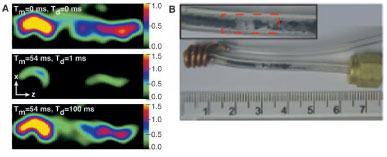博文
Catalysis probed with MRI
|
Scientists have developed a way of peering into a microreactor to watch gases react on a solid catalyst. The technique can highlight 'hotspots' of activity on the catalytic surface, opening a new way for researchers to probe reactions in the millimetre-scale reactors that are increasingly used in 'lab-on-a-chip' technology.
Louis Bouchard of the Lawrence Berkeley National Laboratory in the US and colleagues in the US, Pakistan and Russia, used magnetic resonance imaging (MRI) to observe the hydrogenation of propylene to propane by the organometallic Wilkinson's catalyst immobilised on silica gel in a microreactor. MRI works by applying an external magnetic field to nuclei, whose innate magnetic spins then resonate at a particular frequency. The spins can then be excited by radiowaves and the resulting signal detected and an image of the activity reconstructed.
But gas phase reactions are difficult to image using MRI because gases are highly diffuse so there are too few molecules to obtain a strong enough signal. Furthermore many of the molecules don't have a nuclear spin - so don't produce a signal when they're hit by radiowaves.

|
(A) MRI images show polarised propane moving through the catalyst, revealing whether further reaction takes place. (B) Catalytic reactor with Wilkinson's catalyst powder mixed with glass beads. An enlarged view of the catalyst packing is shown in the inset. The dashed red lines indicate the field of view for the images in (A)
© Science
|
What Bouchard and his colleagues did was to vastly increase the proportion of hydrogen molecules with the 'right' spin characteristics. They did this by chilling the hydrogen gas for the reaction to 77K, which results in a large proportion of the hydrogen nuclei adopting a 'para' configuration of spin polarisation. When the para-enriched hydrogen molecules are incorporated into another molecule - for instance during the hydrogenation of propene (C3H6) to propane (C3H8) - the nuclear spins add up to given an overall spin that can be detected by MRI.
In this way, the researchers were able to map the activity within the catalyst bed.
'Furthermore, by applying an appropriate external radiofrequency we can maintain the polarised state of the propane and further follow its fate through MRI,' Bouchard explained. 'So if in a reactor there are subsequent reactions of the product, we can map these too.'
Patrick Barrie, a member of the magnetic resonance and catalysis group at the University of Cambridge, UK described the work as an elegant combination of two techniques. 'NMR using para-hydrogen induced polarisation, PHIP, has already shed light on hydrogenation reactions using homogeneous catalysts; MRI of liquids reacting in a bed of solid catalyst has already shown the effect of local flow fields on conversion. Here PHIP and MRI are combined to image the gas-phase product from a hydrogenation reaction on a solid catalyst in a microreactor.'
Barrieadded that the technique has great potential. 'However, a difficulty may lie in quantifying the images in order to interpret the results,' he added. 'The images depend critically on the lifetime of the polarised spins, and how the lifetime varies in the vicinity of a solid catalyst surface is not yet really known."
Simon Hadlington
References
L-S Bouchard et al, Science, 2007, 319, 442 (DOI: 10.1126/science.1151787)
https://blog.sciencenet.cn/blog-3913-15126.html
上一篇:催化剂的发现
下一篇:Catalytic cavities

